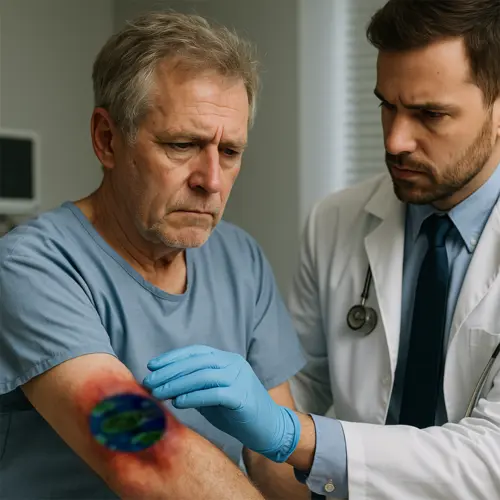First Human Case of Flesh-Eating Bacteria in the U.S. Confirmed
The first human case of flesh-eating bacteria in the U.S. has been confirmed, raising urgent public health concerns. Officials reported that the infection was linked to dangerous bacteria capable of causing life-threatening conditions. Although such cases are rare, experts emphasize the importance of awareness and prevention.
First Human Case of Flesh-Eating Bacteria: Symptoms
The term “flesh-eating bacteria” generally refers to severe infections caused by different pathogens. One major culprit is Vibrio vulnificus, a bacteria found in warm, salty waters. Another is the New World screwworm parasite, recently identified in a U.S. patient who had traveled abroad. Both can cause devastating infections if untreated.
How the First U.S. Case Was Detected
Health authorities confirmed the first U.S. case on August 4. The Centers for Disease Control and Prevention (CDC) worked with state health departments to identify the infection. Thankfully, the patient has recovered, and no secondary infections were reported. Still, officials warn that the risk to public health, though low, should not be ignored.
First Human Case of Flesh-Eating Bacteria: Risk Factors
Certain groups face higher risks, including:
- People with weakened immune systems
- Adults over 65 years old
- Those with liver disease or diabetes
- Individuals with recent surgical wounds, cuts, or tattoos
Exposure is most common when swimming in warm coastal waters or consuming raw shellfish, especially oysters.
Climate Change and Rising Cases
Scientists warn that climate change is fueling the spread of Vibrio bacteria further north along U.S. coastlines. Rising sea temperatures create ideal conditions for the bacteria to thrive, leading to increasing seasonal infections from May to October.
How to Stay Safe: Prevention Tips
Health experts recommend the following precautions:
- Avoid swimming in warm seawater with open cuts or wounds
- Use waterproof bandages if exposure is unavoidable
- Do not eat raw or undercooked shellfish
- Wash hands and skin thoroughly after handling seafood
- Seek immediate medical attention if infection symptoms appear
Government and Public Health Response
U.S. officials have launched containment strategies to prevent further spread. In Texas, authorities are implementing sterilization programs to reduce the population of screwworm flies. Meanwhile, coastal states are intensifying awareness campaigns about Vibrio vulnificus.
Final Takeaway
The confirmation of the first human case of flesh-eating bacteria in the U.S. is a stark reminder of the ongoing risks from both parasites and bacteria. While rare, these infections can be deadly if untreated. By practicing preventive measures and staying informed, individuals can significantly lower their risk.
The following post may interest you
Rats Are Spreading a Deadly Disease: Boston Health Alert
Source
https://gazeteoksijen.com/saglik/abdde-insanda-ilk-kezvida-kurdu-sinegi-vakasi-goruldu-249862

